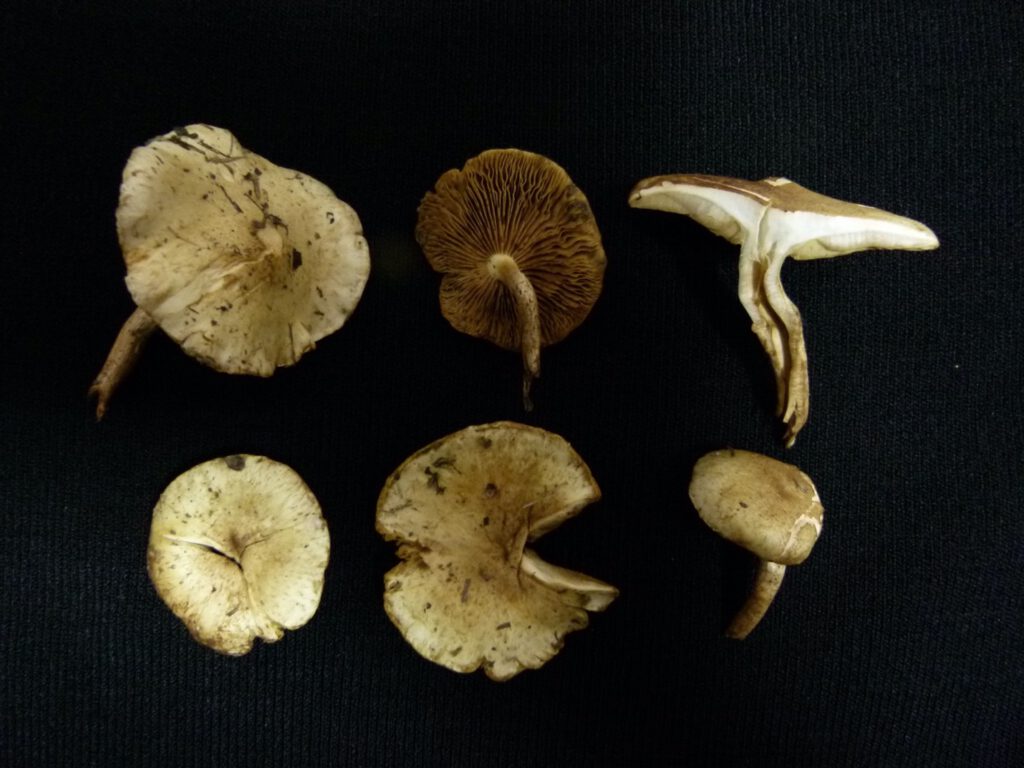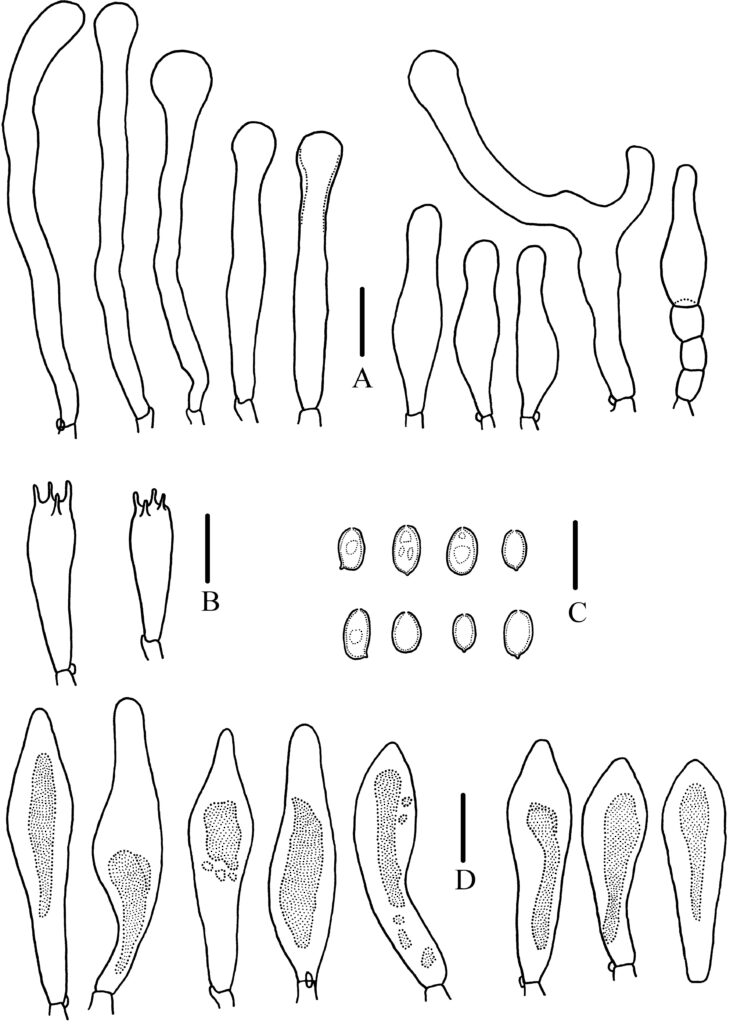Pholiota subcaespitosa E.J. Tian sp. nov. (Figures 3, 4)
MycoBank number: MB 559945; Index Fungorum number: IF 559945; Facesoffungi number: FoF 12907;
Description
Pileus 18–35 mm broad, convex, becoming plane, with obtuse umbo or slightly depressed on the disc in age, with a waved margin at maturity, yellowish white (4A2), fading to near whitish toward margin, light brown (5D4) on the disc, slightly viscid when wet, decorated with brownish fibrillose scales appressed and often not apparent in age. Lamellae adnate to sinuate-uncinate or with a decurrent tooth, light brown to brown, narrow, close, edges even. Stipe 40–70 mm long, 2–5 mm thick, equal, solid becoming stuffed to hollow, dingy pallid, becoming light brownish below, naked above, elsewhere with dingy brown fibrils or scales, Veil fibrillose, leaving an evanescent ring zone. Spore deposit brown. Basidiospores 5–7 × 3.2–4 μm (Q = 1.5–2), in face view elliptic, oblong to subovate, in side view slightly inequilateral, wall smooth and thick, germ pore distinct, sometimes making the spore apex somewhat truncate,rust brown (6E8) to light brown (6D8) in KOH, slightly paler in Melzer’s reagent. Basidia 20–24 × 5.5–6.5 μm, 4-spored, clavate, hyaline in KOH. Pleurocystidia as chrysocystidia, 30–42 × 8–9.5 μm, subfusoid, fusoid-ventricose to clavate-mucronate, with thin and smooth wall, hyaline to yellow brown in KOH, content showing a refractive amorphous inclusion as revived in KOH. Cheilocystidia 20–67 × 5–8 μm, cylindric with subcapitate apex, often flexuous, at times with branches; or fusoid-ventricose, some ventricose with 2-3 short cells chained at base, wall thin, rare slightly thick, hyaline in KOH, rare yellowish, content homogeneous. Gill trama parallel, hyphae 3–24 μm diam., thin-walled, hyaline to yellowish brown in KOH. Pileus hyphae 2–8.6 μm diam., yellowish to yellowish brown in KOH, wall thin, with spiral incrustations. Context hyphae 3–10μm diam., thin-walled, hyaline in KOH. Clamps regularly present.
Material examined: CHINA, Jilin, Saman huanle Valley, Jingyuetan national forest park, Changchun city, Jilin province, 10 September 2016, Guangcheng Cao, HMJAU37330 (holotype); Jingyuetan national forest park, Changchun city, Jilin province, 1 September 2012, Enjing Tian, HMJAU37368
Distribution: China, Jilin, Changchun city, Caespitose on hardwood stumps in autumn.
Sequence data: HMJAU37330: ITS-OP244888.1; LSU-OP223415.1 HMJAU37368: ITS-OP244889.1; LSU-OP223416.1
Notes: This species is characterized mainly by the pileus with umbonate or depressed disc, slim stipe, brownish to brown fibrillose scales on the surface of pileus and stipe, small basidiospores, pleurocystidia as chrysocystidia, cheilocystidia mainly with two shapes: fusoid-ventricose and cylindric with subcapitate, the former small and rare with short cells chained at base, the latter often flexuous and at times with branches.
Pholiota subcaespitosa is similar to P. caespitosa A.H. Sm. & Hesler in shape, germ pore, and size of basidiospores, the pleurocystidia and caespitose growth (Smith & Hesler, 1968). However, the latter lack cylindric cheilocystidia. In the phylogram (Fig. 5), P. subcaespitosa clustered together with P. caespitosa and P. gummosa (Lasch) Singer. P. gummosa has the similar cylindric cheilocystidia with P. subcaespitosa, but the former can be easily distinguished by its absence of pleurocystidia (Smith & Hesler, 1968).

Fig. 3 Basidiomes of Pholiota subcaespitosa (HMJAU37330). Photo by G. Cao.

Fig. 4 Pholiota subcaespitosa A. Cheilocystidia; B. Basidia; C. Basidiospores; D. Pleurocystidia. Bars=10μm. Drawings by E. Tian.
